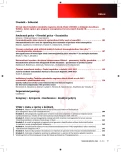Pharmacokinetics as a tool for optimising the treatment of patients with haemophilia
Authors:
J. Blatný 1; O. Zapletal 1; S. Köhlerová 1; V. Fiamoli 1; M. Jelínková 1; P. Ovesná 2
Authors‘ workplace:
Oddělení dětské hematologie, FN Brno, LF MU Brno
1; Institut biostatistiky a analýz, LF MU, Brno
2
Published in:
Transfuze Hematol. dnes,20, 2014, No. 4, p. 103-106.
Category:
Comprehensive Reports, Original Papers, Case Reports
Overview
Prophylaxis is the gold standard of care for persons with severe haemophilia. Prophylactic as well as „on-demand“ treatment is often guided only by the patient’s body weight. There is, however, significant inter-individual variability in factor concentrate clearance as well as in response to treatment between different persons with haemophilia (PWH) and thus the same treatment may lead to significantly different clinical outcomes. With the help of pharmacokinetics, such treatment can be optimized for every individual. PK also has the potential to increase the cost-effectivity of haemophilia treatment. The authors summarized their own experience as well as the literature available on PK-guided treatment in haemophilia and stress the benefits of PK guided therapy for patients, health-care providers and health-care payers.
Key words:
haemophilia, factor concentrate, pharmacokinetics
Sources
1. Nilsson IM, Hedner U, Ahlberg A. Haemophilia prophylaxis in Sweden. Acta Paediatr Scand 1976; 65(2): 129-135.
2. van den Berg HM, De Groot PH, Fischer K. Phenotypic heterogenity in severe hemophilia. J Thromb Haemost 2007; 5(suppl.1): 151-156.
3. Fijnvandraat K, Peters M, Ten Cate JW. Interindividual variation in half-life of infused recombinant factor VIII is related to pre-infusion von Willebrand factor antigen levels. Br J Haematol 1995; 91(2): 474-476.
4. Björkman S, Oh M, Spotts G, et al. Population pharmacokinetics of recombinant factor VIII: the relationships of pharmacokinetics to age and body weight. Blood 2012; 119(2): 612-618.
5. Collins PW, Fischer K, Morfini M, et al. Implications of coagulation factor VIII and IX pharmacokinetics in prophylactic treatment of haemophilia. Heamophilia 2011; 17(1): 2-10.
6. Den Uijl IE, Mauser Bunschoten EP, Roosendaal G, et al. Clinical severity of haemophilia A: does the classification of the 1950s still stand? Haemophilia 2011; 17(6): 849-853.
7. Bjorkmann S. Pharmacokinetics of plasma-derived and recombinant factor IX – implications for prophylaxis and on-demand therapy. Haemophilia 2013; 19(6): 808-813.
Labels
Haematology Internal medicine Clinical oncologyArticle was published in
Transfusion and Haematology Today

2014 Issue 4
- Cost Effectiveness of FVIII Substitution Versus Non-Factor Therapy for Hemophilia A
- Vascular Disease in the Gradually Aging Population of Hemophiliacs: An Underestimated Problem?
- Prognostic Significance of Subclinical Joint Changes on MRI in Hemophilia
- Immunotolerance is still the goal of management of hemophilia A with inhibitor in the era of non-factor therapy
- Minimum and Optimal Factor Levels in Physically Active Hemophiliacs
Most read in this issue
- The significance of heavy/light chain immunoglobulin pairs (Hevylite™) in multiple myeloma
- Activity of Blood Transfusion Service in the Czech Republic 1989–2013
- Retransfusion system with integrated double filtration – parameters of product quality
- Pharmacokinetics as a tool for optimising the treatment of patients with haemophilia
